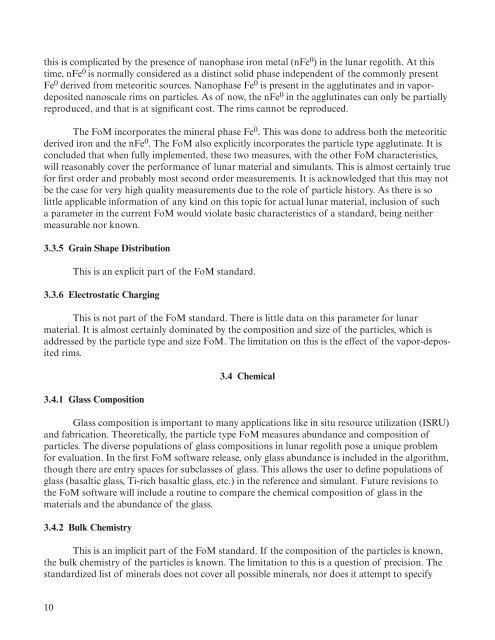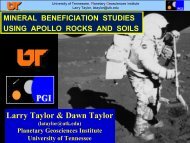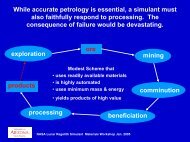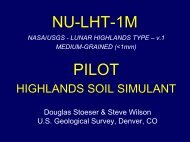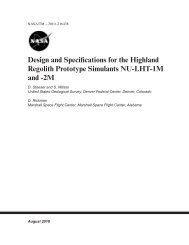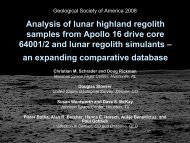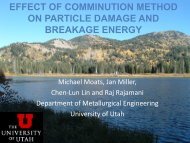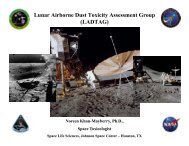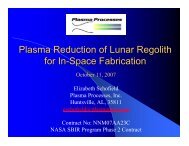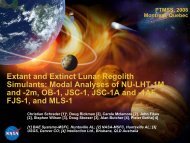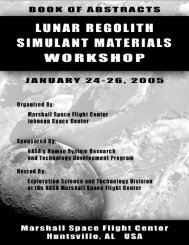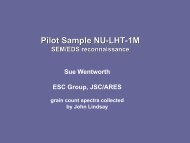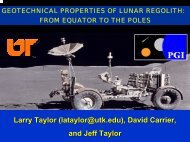Figure of Merit Characteristics Compared to Engineering Parameters
Figure of Merit Characteristics Compared to Engineering Parameters
Figure of Merit Characteristics Compared to Engineering Parameters
You also want an ePaper? Increase the reach of your titles
YUMPU automatically turns print PDFs into web optimized ePapers that Google loves.
this is complicated by the presence <strong>of</strong> nanophase iron metal (nFe 0 ) in the lunar regolith. At thistime, nFe 0 is normally considered as a distinct solid phase independent <strong>of</strong> the commonly presentFe 0 derived from meteoritic sources. Nanophase Fe 0 is present in the agglutinates and in vapordepositednanoscale rims on particles. As <strong>of</strong> now, the nFe 0 in the agglutinates can only be partiallyreproduced, and that is at significant cost. The rims cannot be reproduced.The FoM incorporates the mineral phase Fe 0 . This was done <strong>to</strong> address both the meteoriticderived iron and the nFe 0 . The FoM also explicitly incorporates the particle type agglutinate. It isconcluded that when fully implemented, these two measures, with the other FoM characteristics,will reasonably cover the performance <strong>of</strong> lunar material and simulants. This is almost certainly truefor first order and probably most second order measurements. It is acknowledged that this may notbe the case for very high quality measurements due <strong>to</strong> the role <strong>of</strong> particle his<strong>to</strong>ry. As there is solittle applicable information <strong>of</strong> any kind on this <strong>to</strong>pic for actual lunar material, inclusion <strong>of</strong> sucha parameter in the current FoM would violate basic characteristics <strong>of</strong> a standard, being neithermeasurable nor known.3.3.5 Grain Shape DistributionThis is an explicit part <strong>of</strong> the FoM standard.3.3.6 Electrostatic ChargingThis is not part <strong>of</strong> the FoM standard. There is little data on this parameter for lunarmaterial. It is almost certainly dominated by the composition and size <strong>of</strong> the particles, which isaddressed by the particle type and size FoM. The limitation on this is the effect <strong>of</strong> the vapor-depositedrims.3.4.1 Glass Composition3.4 ChemicalGlass composition is important <strong>to</strong> many applications like in situ resource utilization (ISRU)and fabrication. Theoretically, the particle type FoM measures abundance and composition <strong>of</strong>particles. The diverse populations <strong>of</strong> glass compositions in lunar regolith pose a unique problemfor evaluation. In the first FoM s<strong>of</strong>tware release, only glass abundance is included in the algorithm,though there are entry spaces for subclasses <strong>of</strong> glass. This allows the user <strong>to</strong> define populations <strong>of</strong>glass (basaltic glass, Ti-rich basaltic glass, etc.) in the reference and simulant. Future revisions <strong>to</strong>the FoM s<strong>of</strong>tware will include a routine <strong>to</strong> compare the chemical composition <strong>of</strong> glass in thematerials and the abundance <strong>of</strong> the glass.3.4.2 Bulk ChemistryThis is an implicit part <strong>of</strong> the FoM standard. If the composition <strong>of</strong> the particles is known,the bulk chemistry <strong>of</strong> the particles is known. The limitation <strong>to</strong> this is a question <strong>of</strong> precision. Thestandardized list <strong>of</strong> minerals does not cover all possible minerals, nor does it attempt <strong>to</strong> specify10


